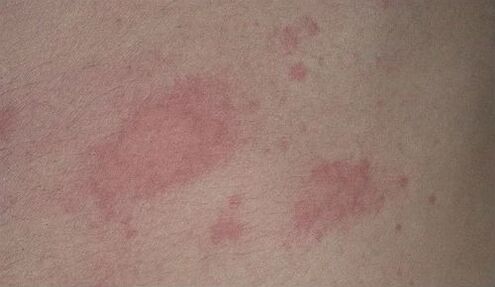
If you suspect you have the disease but don't know what psoriasis looks like and how to treat it, you should learn more about the disease and see a dermatologist urgently.
What the early days of psoriasis look like: symptoms, photos
The rash is characteristic of any stage of psoriasis. Even at the very beginning of development, the disease manifests in different ways. In some cases it starts active and develops rapidly, while in others it shows small and slow manifestations. Regardless, without medical attention, the disease develops and captures larger and larger areas of skin.
The initial stages of the disease in the form of small rashes (pimples) can make diagnosis difficult. Over time, the rash can grow and combine into patches covered with horny scales. It is important to diagnose psoriasis in its initial stages so that treatment can begin immediately. The result of treatment will be long-term remission, in some cases 3-4 years.
Psoriasis is characterized by the following locations on our skin:
- small back
- knees and elbows
- groin fold
- head
- calf
The disease takes many forms, each with its own distinct characteristics. Depending on where and how the pimples appear, this will depend on the type of psoriasis diagnosed by the dermatologist.
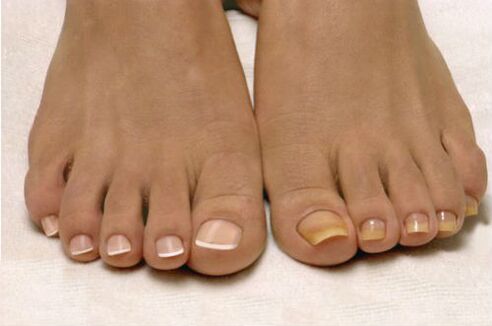
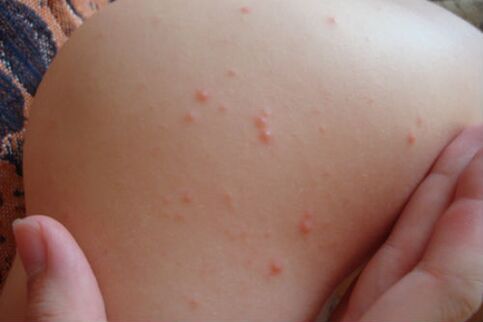

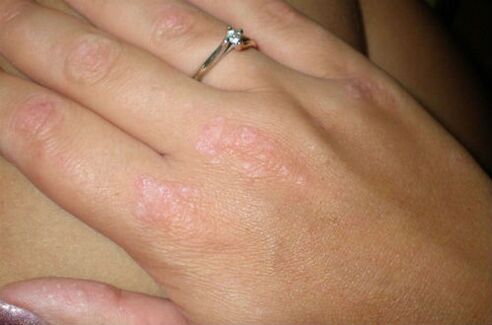

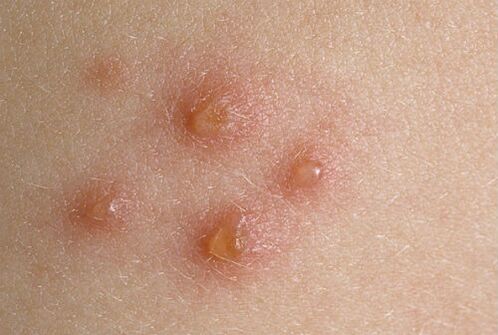
A rash is unhealthy under any circumstances, but the following symptoms are most likely related to psoriasis:
- The spots are red, slightly raised, and covered with scales (dead cells) that flake off.
- Plaques appear anywhere, more commonly in the knee and elbow area. Sometimes they itch.
- Nails fall off and deform.
- On the feet, palms, painful blisters that itch.
What are the forms of psoriasis
The most common form is plaque psoriasis. It is also often called ordinary or vulgar. In all cases, this form of the disease occurs in up to 90% of cases.
Psoriasis vulgaris is characterized by raised red patches with gray or white scales. Infected skin becomes inflamed, easily injured, and bleeds as the scales fall off. Over time, patches on the skin can grow and coalesce into large areas because. Called "Paraffin Lake".
Called the inverse, the curved surface of psoriasis is a smooth, slightly prominent red patch that barely peels off. The localization of the spots is mainly in the skin folds: groin and armpits, external genitalia, abdominal folds and mammary glands (obesity).
Spread to other areas of the skin is minimal, but this form of treatment is complicated by sweating due to natural friction during exercise. Reverse psoriasis may be accompanied by streptococcal pyoderma or mycosis if left untreated.
Guttate psoriasis is uncommon and is a complication of streptococcal infection. It is characterized by small, teardrop-shaped lesions. Another distinguishing feature of guttate psoriasis is the color of the psoriatic plaques, which can range from red to purple. The affected area is widespread, most commonly the buttocks, but can occur in other areas of the skin.
One of the most severe forms is attributed to pustular psoriasis. Its symptoms are blisters (pustules) with clear fluid. The skin under and around them becomes inflamed. When the blisters become infected, the clear fluid fills with pus, which peels off easily but is difficult to treat. Where to locate - calf and forearm.
Psoriatic nail dystrophy occurs on the nails of the hands and feet. This form can cause nail changes. They can change color and appear as dots or lines. More severe forms are characterized by delamination or complete loss of the nail.
Psoriatic arthritis accounts for only 10% of cases. This form affects joints and connective tissue. It mainly affects the fingers. In some cases, psoriasis can affect the hip, knee, and spine joints. This can lead to psoriatic spondylitis. In the overt form of psoriatic spondylitis, patients are unable to move independently.
Erythrodermic psoriasis is characterized by extensive inflammation, which can occur in the context of exacerbation of psoriasis vulgaris. It can be fatal because of the loss of the natural ability to regulate body temperature due to extensive inflammatory foci.
development of psoriasis
Psoriasis can affect different parts of the body and have different symptoms. Let's consider a different situation.

Appears on the scalp, behind the ears. The pimples in these areas are itchy and may be cracked and moist.
physically
The nature of the plaques on the body and their intensity depend on the form of psoriasis. Initial psoriasis on the body manifests in different ways: from a single rash to a large area.
on hand
The plaques first appear on the elbows, forearms, and then spread to the palms and fingers.
on foot
The initial manifestations start in the knee or foot and then progress to other areas.
on elbows and knees
Psoriasis in these areas looks like a red, scaly rash where the skin is rough.
on the palm
When other areas become infected, plaques in these places can appear. If left untreated, psoriatic arthritis can develop, which can be dangerous.
on the face
Rarely happens in this area. Affects nasolabial folds area, eye area, cheeks. Sometimes it spreads to the mucous membranes of the tongue and cheeks.
on the nails
In appearance, it can be confused with fungus, which starts with spots, furrows and ends with complete exfoliation.
Attacks of psoriasis in children
The childhood version of the disease, especially in infants, is symptomatic and is often confused with diaper rash or diaper dermatitis. Subsequently, where the redness occurs, the upper layer of the skin peels and is accompanied by severe itching. It is very important not to bring the disease to this stage as this can cause discomfort to the baby.
Additionally, psoriasis can manifest on the head in children, a condition characterized by crusts that leave small wounds when they flake off. Under no circumstances should you self-treat your child just because you know what psoriasis looks like to avoid complications from the disease.
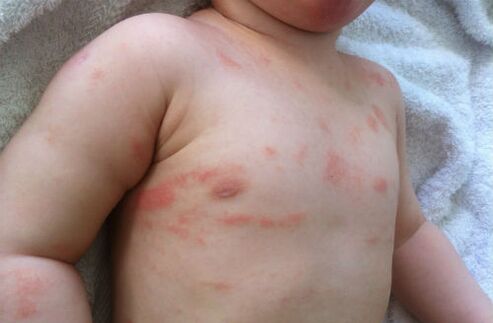
Causes of Psoriasis
Psoriasis is not contagious, and scientists have identified several reasons why it occurs. In addition, childhood psoriasis (up to 10 years old) has been shown to occur due to heredity, i. e. having relatives in the family with a similar condition. Later cases were associated with other causes.
If we combine all the factors that trigger psoriasis, its performance can be attributed to the following:
- alcohol abuse
- hereditary
- excessive hygiene
- dry skin
- pressure
- take medicine
- Staphylococcal and fungal infections
initial treatment
If you are diagnosed with psoriasis, you must follow a diet and start treatment early, as it is easier and faster to cure psoriasis. Before psoriasis plaques start to grow, your dermatologist will most likely recommend topical treatment with the following creams:
- Naftalan ointment. Prescribe at the initial stage and heal. Anti-inflammatory and antipruritic.
- Sulfur tar ointment. Relieves inflammation, only for "dry" psoriasis. The ointment should not be applied to the face.
- Salicylic acid ointment. Contains salicylic acid to soften and easily remove scales.
drug
In addition to ointments, treatment includes physiotherapy procedures (electrosleep, magnetic therapy, UV radiation, etc. ), drugs, vitamin complexes. The complete complex is available in progressive and severe forms.
Medications are prescribed only after the exam and usually include a set of medicines:
- antihistamines,
- diuretics,
- immunomodulators,
- immunosuppressants,
- Antidepressants,
- NSAIDs (a group of non-steroidal anti-inflammatory drugs),
- Intestinal Adsorbent,
- Vitamin complex.
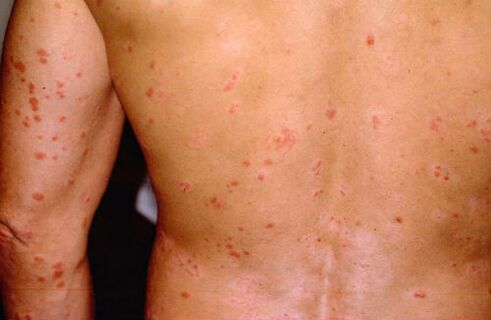
folk remedies
Traditional healing, especially at the primary stage, can be combined with traditional healing formulas. One of the recipes suggested using celandine juice. Spots have to be smeared with fresh juice all summer long, and then by the end of summer, the size of the patches has decreased significantly. If you perform the procedure three summers in a row, the spots should disappear forever.
For early psoriasis, the following formula is suitable - beaten egg ointment. Easy to prepare: 2 eggs, 1 tablespoon. l. Vegetable oil, stir well, add 0. 5 tbsp. l. Acetic acid. This mixture can be stored, but only in an airtight container and in a dark place. To use: Apply every night to areas affected by psoriasis.
You can also prepare an oil ointment, which can be of great help in treating psoriasis. You need to take 300 grams of fat, 2 chicken yolks and 100 grams of linden honey. Use within two weeks. Apply to sore 3 times a day, leave on for 2 hours, then rinse. After two weeks, prepare another batch by adding 2 tablespoons. l. Celandine powder. This essay is designed to be one hour long.
In addition to psoriasis ointments, you can add therapeutic baths like sea salt or walnuts. Such bathing is useful not only in the early stages, but also during the exacerbation of the disease. For a bath, you need to prepare leaves or shells, about 400 grams. Pour boiling water over it, let it sit for 10 minutes, then filter. The filtered solution is used in a therapeutic bath and must be taken within half an hour.
How to Prevent Psoriasis
It's well known why plaque psoriasis occurs, but it's not fully understood why it takes some forms. The disease can manifest after stress, immune system failure, previous infection or genetic level.
To protect yourself from relapse, you need to quit bad habits. Additionally, doctors recommend moisturizing dry skin well and avoiding burns, hypothermia, and skin damage as much as possible. Also, be careful when taking antibiotics, vaccines, and beta-blockers, as they can make the condition worse.
Avoiding infections, living a healthy lifestyle, not overworking, avoiding stress and worry - these measures will also help prevent psoriasis to some extent.
Psoriasis is a condition that requires treatment, but it can be confused with similar skin conditions. This is why you should not diagnose yourself based on photos, and more importantly, prescribe treatment without the necessary knowledge.























